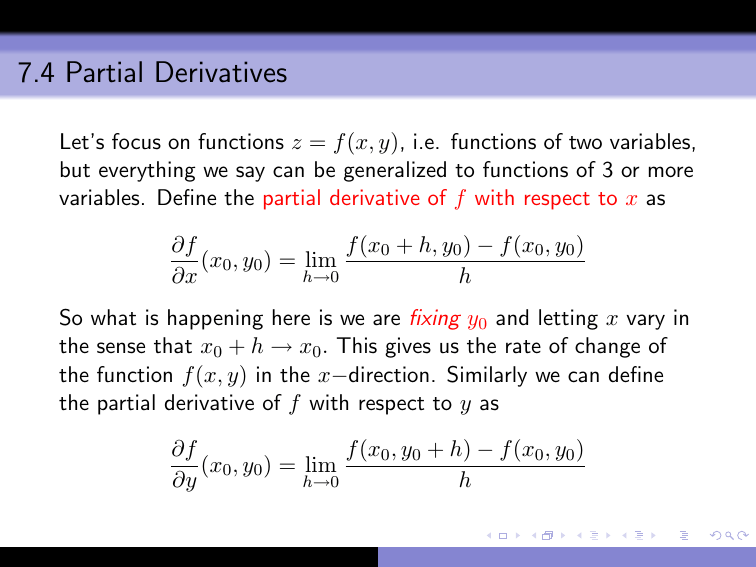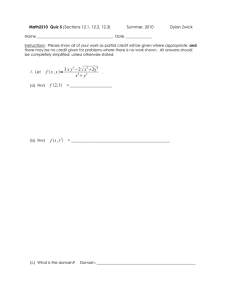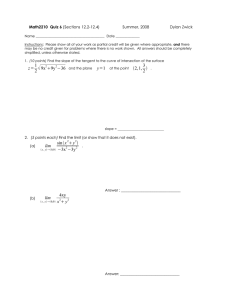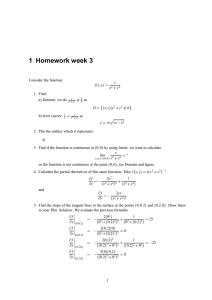Partial Derivatives: Calculus Lecture Notes
advertisement

7.4 Partial Derivatives Let’s focus on functions z = f (x, y), i.e. functions of two variables, but everything we say can be generalized to functions of 3 or more variables. Define the partial derivative of f with respect to x as ∂f f (x0 + h, y0 ) − f (x0 , y0 ) (x0 , y0 ) = lim h→0 ∂x h So what is happening here is we are fixing y0 and letting x vary in the sense that x0 + h → x0 . This gives us the rate of change of the function f (x, y) in the x−direction. Similarly we can define the partial derivative of f with respect to y as ∂f f (x0 , y0 + h) − f (x0 , y0 ) (x0 , y0 ) = lim h→0 ∂y h Sample partial derivatives Let f (x, y) = x3 y 4 then ∂f (x + h)3 y 4 − x3 y 4 (x + h)3 − x3 4 (x, y) = lim = lim y h→0 h→0 ∂x h h d 3 4 x y = dx 2 4 Therefore it is easy to see that ∂f ∂x (x, y) = 3x y . This simple example illustrates a more general rule which is that when you are taking the partial derivative with respect to x, you treat y as fixed, or as a constant. So what would ∂f (x, y)? ∂y ∂f (x, y) = 4x3 y 3 ∂y Practice some examples We will go over the answers to these in class. For each function ∂f f (x, y) find ∂f dx and ∂y : Don’t forget the chain rule, product rule, and quotient rule. f (x, y) = xn y m (here m, n are any real numbers) f (x, y) = xye1−x 2 +y 2 f (x, y) = x ln(2x − y 2 ) f (x, y) = 2x2 x2 + y 2 Examples, solutions f (x, y) = xn y m (here m, n are any real numbers) ∂f ∂f = nxn−1 y m and = mxn y m−1 ∂x ∂y f (x, y) = xye1−x 2 +y 2 ∂f 2 2 2 2 = ye1−x +y − 2x2 ye1−x +y ∂x ∂f 2 2 2 2 and = xe1−x +y + 2xy 2 e1−x +y ∂y Examples, solutions f (x, y) = x ln(2x − y 2 ) 2x ∂f = ln(2x − y 2 ) + ∂x 2x − y 2 f (x, y) = and ∂f −2xy = ∂y 2x − y 2 2x2 x2 + y 2 ∂f 4x(x2 + y 2 ) − 4x3 = ∂x (x2 + y 2 )2 and ∂f −4x2 y = 2 ∂y (x + y 2 )2 Interpreting partial derivatives as slope As in single variable calculus, the partial derivative represents the slope, though now it is the slope of a tangent plane at a point on a surface, and there are two slopes, representing the change in the ∂f x−direction ( ∂f ∂x ) and the change in the y−direction ( ∂y ). For any function z = f (x, y) you can ask for the values of the slope of the tangent plane at a point, so given a point (x0 , y0 ) you will ∂f compute ∂f ∂x (x0 , y0 ) and ∂y (x0 , y0 ). For example:pFind the slopes of the tangent plane to the surface of f (x, y) = 1 − x2 − y 2 at (x, y) = (0, 0). Interpret this graphically. We will go over this in class. What if the point in question was (x, y) = (1/2, 1/2)? or (x, y) = ( √12 , √12 )?



